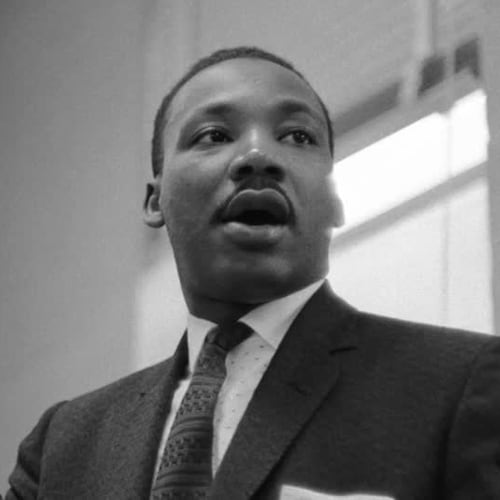Editor’s Note: This story is one in a series of Black History Month stories that explores the role of resistance to oppression in the Black community.
Long before Evander Holyfield, Atlanta had another champion who helped put the city’s boxing scene on the map. In 1926, Theodore “Tiger” Flowers became the first Black man to win the world middleweight championship.
Inside the ring, the evasive southpaw racked up the bouts, defeating some of the top boxers of his time on the way to the title. The well-liked prizefighter was known as “The Georgia Deacon” because he was a devoutly religious man who spent his Sunday mornings serving as a steward at the Butler Street CME Church.
He also carried a Bible with him into the ring and liked to read his favorite passages to whomever would listen.
“He was an absolutely incredible figure in Georgia’s history and the history of boxing,” said the Rev. Herman “Skip” Mason, an Atlanta historian and pastor who wrote about Flowers in his book “Black Atlanta in the Roaring Twenties.”
While most fighters of that era were boisterous and egocentric, Flowers was relatively reserved. He was wealthy for that period and lived in a sprawling mansion, but he gave much of his money to Atlanta’s Black colleges, his church and the local orphanage.
“His character was what was so special about him,” said Mason, noting Flowers’ legacy in Atlanta is one of philanthropy. “He was not a typical braggadocious, boastful pugilist. He was very much a spiritual person.”
In all, Flowers recorded 115 victories in 157 fights, 53 of which came by knockout, according to the International Boxing Hall of Fame.
“He had an extraordinary boxing record,” said Paul Crater, vice president of collections and research services at the Atlanta History Center. “He was really a well-liked fighter. And he seemed to be appreciated in Georgia both by the Black Community and the white community.”
Credit: Courtesy of the Atlanta History Center
Credit: Courtesy of the Atlanta History Center
Born in Camilla, Georgia, in 1895, Flowers was raised in Coastal Georgia and began his boxing career at 23 while working in a Philadelphia shipbuilding plant. He moved to Atlanta in 1920, where he was trained by manager Walk Miller. He became the first Black middleweight champion six years later, defeating Harry Greb in front of a crowd of more than 16,000 at Madison Square Garden.
Along the way he earned the admiration of Black and white fans who were likely enamored by both his spirituality and his athletic prowess in the ring, Crater said.
“That was one of the aspects of his personality that resonated in a universal way,” Crater said of his faith.
Atlanta City Councilman Michael Julian Bond said as good a fighter as Flowers was, it was the way he carried himself outside the ring that really drew people to the world champion.
“He had some philanthropic tendencies around the Black community in Atlanta and was generally well thought of,” Bond said. “He was a fierce fighter in the ring, a clean competitor, but the way he conducted himself away from boxing made him an example to many.”
Flowers died at the height of his popularity of complications from a relatively minor procedure to remove scar tissue from around his eyes. He was 32. Interestingly, the former champion Greb died months earlier during his own procedure to repair damage sustained in the ring.
Credit: Courtesy of the Atlanta History Center
Credit: Courtesy of the Atlanta History Center
What’s remarkable, historians say, is how many Atlanta residents attended the Flowers’ viewing and funeral service. Some 75,000 people walked by the former champ’s casket to pay their respects in November 1927, and so many people came the memorial service that the city allowed Flowers’ family to use its public auditorium.
Only Martin Luther King Jr.’s funeral drew more visitors to Atlanta when he was assassinated 41 years later, Mason said.
Credit: Courtesy of the Atlanta History Center
Credit: Courtesy of the Atlanta History Center
Years after Flowers’ death, but still well before the start of the civil rights movement, city officials renamed a street for the boxing great. It was a rare tribute for a Black man living in the Jim Crow South, where many streets were named for Confederate generals.
“That’s extraordinary,” said Crater, who works at the history center. “I’m not aware of another Black athlete that early who had a street named after him. Obviously, he was very popular.”
Growing up in the 1970s, future heavyweight champion Evander Holyfield said he idolized Muhammad Ali and the Spinks brothers as he started his boxing career. It had been decades since Flowers’ died, but Holyfield still heard trainers and fans across the South raving about what an excellent fighter “The Deacon” had been.
“He was a tough customer and he was highly respected by a lot of people,” Holyfield said.
At the height of his career, Flowers built a sprawling 20-room estate along Simpson Road, which is now Joseph E. Boone Boulevard in northwest Atlanta. The home fell into disrepair in the decades after his death and the property was eventually sold to the city for the construction of Fire Station 16. The facility housed Atlanta’s first Black firefighters.
Two historical markers sit outside the firehouse, and the men who work there are well aware of its history. There’s a sense of pride that comes with working out of that station, said Capt. John Rhodes, especially for Atlanta’s black firefighters.
“It means a lot to me. (The first Black firefighters) paved the way for me to first get the job, and second to get promoted and rise through the ranks,” said Rhodes, who has been with Atlanta Fire and Rescue 23 years. “They were the trailblazers that allowed me to get where I am.”
SOURCES: New Georgia Encyclopedia, the International Boxing Hall of Fame and others.
About the Author
The Latest
Featured
![Theodore 'Tiger' Flowers (professional boxer) is buried in Lincoln Cemetery in Atlanta (Fulton County.) Photo contributed by Chicago Daily News [Public domain], via Wikimedia Commons](https://www.ajc.com/resizer/v2/RGVUJZTPANCK45K4LDLL5VSDRA.jpg?auth=a5b21005601f0a669daccad73be2e202d20f802fd5bf37c1b1df200415519e2e&width=600&smart=true)




